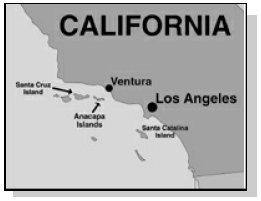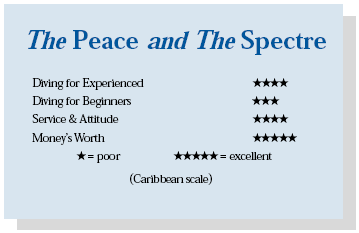The Channel Islands, Southern CaliforniaContents of this Issue: When Your Dry Suit Will Double as Day Wear The Channel Islands, Southern California The Truth About San Salvador’s Algae $5,000 Reward for Errant Spearfisherman When A Travel Agent Sticks To “Its Rules” Editorial Office: Ben Davison Publisher and Editor Undercurrent 3020 Bridgeway, Suite 102 Sausalito, CA 94965 great boat diving for $100/day with room and board from the August, 2001 issue of Undercurrent
I awoke in my bunk rocking from side to side. Somehow I’d slept through the 6 a.m. flurry of activity as most other divers climbed aboard and set up their gear. I’d missed the Captain’s initial loudspeaker announcements, missed the engines firing, and even missed our ten-minute trip through Ventura harbor. Now we were in the channel headed 14 miles into the Pacific toward the Anacapa Islands. Rolling out of my warm cocoon I grabbed my dry bag and headed up the stairs to the main deck where divers were drinking coffee, swapping lies, and setting up their gear. Since I’d set up the night before I had nothing better to do than dig into the continental breakfast laid out in the main cabin. Ninety minutes later we were anchored off the west end of Anacapa, gates were open, and I jumped into the 53-degree water. Visibility ran 45 feet and I powered down along the anchor line through a thick school of indigo-blue blacksmiths in tight formation. On the 60-foot bottom, maroon spiny urchins pushed against the standard black spiked devils, and, with beautiful blue urchins, covered the volcanic rocky substrate. Half a dozen iridescent orange Garibaldi nibbling on algae chased each other away from their territories. Climbing onboard after 55 minutes, I babbled about the horn shark near the anchor, the 30-inch lingcod, the huge schools of golden senorita, and the juvenile sheepshead lazing about. Talking with veterans, I identified the fat slug-like sea hare and Spanish shawls, which are brilliant blue and orange nudibranchs. Other divers raved about the platter-sized electric ray they’d scared off the bottom. Hunter/gatherers had harvested both scallops and lobster. “Ah yes,” I said, as I dipped water out of the hot tub and poured it down my 6mm suit, “this is going to be a great week of diving. ” I’d flown from the East Coast into LA and rented a car. The drive to Ventura Harbor took nearly three hours, with all the stop-and-go follies on I405. The harbor/ marina itself is an eclectic mix of long liners, squid boats, and other working vessels, along with an array of pricey pleasure craft. Three individually owned dive boats call this home port; I lived on and dived from two, the 65- foot Peace, owned by Eric Bowman, and the 85-foot Spectre, skippered by Ted Cumming. The third boat, Liberty, had pulled itself out of the dive market to offer day-long whale watching tours. A couple of e-mails and a phone call or two and I booked the Peace for my first day and the Spectre for the remainder of my trip. Each vessel runs 4-dive
single day trips, threequarter
day three-tank trips, overnighters, multi-day charters, and
specialty free diving and hunting trips. On the
three-quarter day trips ($65), they include
breakfast, lunch, and air fills. As one might expect, there are tradeoffs. This isn’t Peter Hughes level of luxury. California dive boats are sturdy, practical vessels, built to run year-round far offshore in rough seas. The main salons have an air of ‘crew boat’ practicality and are outfitted with vinyl-covered bench and table seating designed for dripping divers who wear their wetsuits all day. Sleeping accommodations consist of below-deck bunk rooms with an assortment of double and single berths that vary from vessel to vessel. (While the boats sleep 30-40 people, there were never more than a dozen staying all night in the harbor.) Curtains provide privacy, fans keep the air moving. If you don’t like hearing your neighbors snore, bring earplugs. On open boat non-chartered trips such as mine, bed assignments were on a first come, first claimed basis. I managed to snag a double bunk each night, but on sold out trips, late arrivals could get caught bunkless. The heavy cloth or vinyl-covered foam mattresses were comfortable and both boats supplied blankets and pillows. If you want sheets, a sleeping bag or a towel, bring them. Each boat had hot water showers built into the maindeck unisex heads. The Peace had an additional open air shower on the dive deck, the Spectre had a below-deck shower and toilet and more room in the on dive deck units. Both boats had laundry facilities below deck. Because I’d be sleeping in port each night, I took the minimum and changed towels and clothes from my car trunk. Storage space is at a premium, so pack light in soft-sided bags. The open-air dive deck, a third of the length of each boat, had gear racks along the sides and down the middle on The Spectre . Air-fill whips poking out of each rack allowed for quick fills as divers came aboard and tagged their tanks. The Spectre had more spacious gear stations but pumped only air. The Peace was a little tighter but pumped free Nitrox. They gave detailed briefings with discussions of how the current was running, and how to best dive the site. Entry was via a giant stride off the sides. Exiting divers passed up cameras, spears, and game bags, then flopped on the full width swim platforms where crew members pulled off your fins. Then, with the rest of my gear still strapped on, I climbed one of the two ladders to the dive deck and waddled to my station. Both boats had attentive crews, with someone always specifically watching for divers, while others were there to help you exit. No one logged divers’ depth or time. No site was deeper than 70 feet or so. To keep the divers fueled, the cooks piled the plates with kilo-calories. The Peace gets my nod for a better meal. Their cook laid out greater selections for breakfast: fruits, cold cereal, bagels, English muffins, and lunch was a giant Mexican spread with beans, rice, tortillas, fajitas, guacamole, and salads. The Spectre was like an American-style luncheonette, with ala-carte items from their menu if you let the cook know early; otherwise you got the special of the day. I feasted on their Egg-McDiver breakfast sandwiches and enjoyed both the chicken plate lunch and the barbecue platter, which included rice, fresh garden and pasta salads, bread, and a drink. The Spectre sells beer on the ride home, the Peace is BYOB. Hanging out at the docks in the evenings wasn’t as boring as I imagined. The
attractive marina had an interesting mix of clubs, shops, and restaurants, and a
convenience market. The dive shop, which supplies the boats with tanks and rental
gear, was well-stocked and reasonably priced, and provided me with hours of good
camaraderie and impulse buying. Nevertheless, I came for the diving, which pleasantly surprised me. Water temps in early March were between 510- 5 50 (it can near 7 00 in the summer). Air got up to 7 00 with alternately sunny and overcast days. Seas varied from flat to 4 to 5-foot rollers, with visibility from 30 to 50 feet. Although these conditions pale when compared to warm water Caribbean diving, the shear density of the biomass more than makes up for any times that I got chilly. At Santa Cruz, at “Little Scorpion,” I played tag in the kelp forest with a pair of friendly California sea lions. Monstrous spider crabs wandering the bottom attacked my camera when I got close to take their portrait. At “Lobster Spot,” dozens of horn sharks plied the bottom. Out of the corner of my eye I spotted a large white flash and turned to catch a harbor seal dart into a cave cut into the shear rock. Waiting him out at the entrance, he rewarded me with pudgy-faced closeups. After heading to the surface for air, he returned to look me over again. On the protected marine reserve on the north side of East Anacapa, I saw large gamefish that wouldn’t be around for long on unprotected sites. Big sheepshead proudly sported their signature red stripes, while schooling perch and opaleye cruised the top 20 feet of the kelp. Three-pound lobsters pushed and nudged each other, jostling for a better position in their holes. Even an amateur like me could find palm-sized scallops. At “Landing Cove” a big green moray shot across a sand patch and scared up a halibut. Later, I entered a cave at the base of the lighthouse to see walls covered in red rock shrimp and the floor littered in lobster. On West Anacapa “Cat Rock,” hairy-legged orange and yellow brittle stars covered a landscape broken only by multi-hued anemones, giant blue sea stars, and foot-long green sea cucumbers. Yet my favorite denizens of California waters were the fields of kelp, replete with the feisty Garibaldi. Although much of the kelp around the Channel Islands died during the last El Niño, several sites held large forests of fronds. At “Underwater Island,” dozens of bright orange Garibaldi raced back and forth, sometimes hiding, sometimes aggressively chasing me off. Shaking and shivering after 61 minutes, I lumbered aboard and heard the captain announce, “Gray whale dead ahead off the bow.” As usual I was out of film. Oh well, I just popped a cold beer, climbed into the hot tub, and enjoyed the ride back across the channel. Just another fine day of California diving. -- A.N. |

I want to get all the stories! Tell me how I can become an Undercurrent Online Member and get online access to all the articles of Undercurrent as well as thousands of first hand reports on dive operations world-wide
| Home | Online Members Area | My Account |
Login
|
Join
|
| Travel Index |
Dive Resort & Liveaboard Reviews
|
Featured Reports
|
Recent
Issues
|
Back Issues
|
|
Dive Gear
Index
|
Health/Safety Index
|
Environment & Misc.
Index
|
Seasonal Planner
|
Blogs
|
Free Articles
|
Book Picks
|
News
|
|
Special Offers
|
RSS
|
FAQ
|
About Us
|
Contact Us
|
Links
|
3020 Bridgeway, Ste 102, Sausalito, Ca 94965
All rights reserved.

 On the 4-dive
days ($70), food and air fills are additional,
and you pay to rent tanks and weights. For
downright cheap multi-day diving you can mix
and match the trips on the various boats and
sleep aboard at no extra charge. That’s right,
no motel bill!
On the 4-dive
days ($70), food and air fills are additional,
and you pay to rent tanks and weights. For
downright cheap multi-day diving you can mix
and match the trips on the various boats and
sleep aboard at no extra charge. That’s right,
no motel bill!
 Each evening I’d wander over to the adjacent surfing
beach and sit on the driftwood to
watch the sunset. Then, back to
the marina for dinner. My favorite
restaurants were Spinnaker Seafood
and Frullati’s where I hung out
for hours listening to an incredible
blue grass band one night and
fine classical guitar the other.
Each evening I’d wander over to the adjacent surfing
beach and sit on the driftwood to
watch the sunset. Then, back to
the marina for dinner. My favorite
restaurants were Spinnaker Seafood
and Frullati’s where I hung out
for hours listening to an incredible
blue grass band one night and
fine classical guitar the other.
 Diver’s Compass: The
Peace (805) 984-2025; The
Spectre (805) 483-6612 or
book these and The Liberty, (800) 494-2836
Diver’s Compass: The
Peace (805) 984-2025; The
Spectre (805) 483-6612 or
book these and The Liberty, (800) 494-2836
